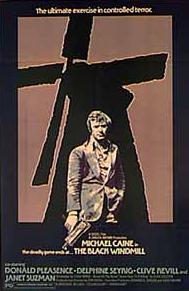 THE BLACK WINDMILL (1974)
THE BLACK WINDMILL (1974)

THE BLACK WINDMILL poster artwork
MICHAEL CAINE.....Major John Tarrant
DONALD PLEASENCE.....Cedric Harper
JOSEPH O'CONOR.....Sir Edward Julyan
JOHN VERNON.....McKee
JANET SUZMAN.....Alex Tarrant
DELPHINE SEYRIG.....Ceil Burrows
Produced and Directed by DON SIEGEL
Written by LEIGH VANCE
REVIEW BY BENJAMIN HALLIGAN
This film from Don Siegel's final years is closer to the lazy and shapeless Telefon (1977) than the efficient and ruthless Charley Varrick (1973), even though there are only a couple years between them. The usual assembly of lone heroes and corrupt figures of authority are on display. Women function only as incompetent secretaries, bitter divorcees and honey-traps.
Michael Caine plays a lone secret agent, rapidly pitted against the corrupt higher echelons of MI6, his son's life at stake in a mysterious blackmail scenario. Quite audaciously, the source of the corruption turns out to be nothing more than a senior MI6 officer, disgruntled at the prospect of a lowly pension. This, no doubt, would leave some viewers feeling short-changed: clearly the film is set in one of the few weeks of the 1970s
when the Soviet Union wasn't attempting to implement a fiendish plan for immediate world domination. As it stands, this is certainly a case of art pre-empting life. The story anticipates the pensionless and disgruntled senior spy Peter Wright's battle with the British Conservative Government in the mid-1980s over the revelations in his book Spycatcher. And, in fairness, both Spycatcher and The Black Windmill present very similar portraits of the British Intelligence Community in the 1970s---more concerned with the crossword in The Times than national security.
Siegel takes a tourist's eye view of London and Hitchcock's eye for set-pieces (indeed, the film culminates in a shoot-out in a windmill, "recalling" Hitch's Foreign Correspondent, 1940). In between, a host of British character actors and Siegel regulars either chase after each other or spout Cold War paranoia at each other. The latter now seems hopelessly dated and laughably naïve. The theatricality of these scenes is punctuated by things blowing-up---from vans to suitcases.
In the tradition of the 1970s International Co-Production (now usually referred to as Europuddings), the action shifts from British country houses and West London to Parisian cafes and a variety of police stations. The film is notably dingy in some places---in a badly-lit way that is unique to British genre films from this period. At other times, the film breaks free of the run-of-the-mill potboiler and Siegel tries a variety of camera tricks with varying degrees of success. In a shot that seems indebted to the French New Wave, Siegel circles a coach with a handheld camera, the clouds reflected in the windows, until he locates Caine amongst the extras. But these fail to
lift the aesthetic of the film to the level of invention that distinguished Dirty Harry (1971).
Despite all this, and its sub-James Bond antics, the film remains curiously compelling. This seems to come entirely from the performances of the leads. Caine delivers a typically cold and unemotional performance, his immense screen presence eclipsing an otherwise underdeveloped character. Donald
Pleasence, seemingly still suffering from the same cold he sported two years earlier in Death Line (1972), embodies perfectly the ambiguity of his character in the film. At times he appears weak and trampled-upon by his superiors, at other times he seems all-powerful, amoral and ruthless. His curious tick---twisting his moustache nervously---marks him as a defector from the first few minutes of the film. Taking a leaf from the book of Caine's superior in the not dissimilar The Ipcress File (1965), he proceeds to bollock him at every opportunity.
Review courtesy of Benjamin Halligan.
Review © 1999 Benjamin Halligan. All Rights Reserved.
Poster artwork © 1974 UNIVERSAL PICTURES. All Rights Reserved.
Title and logo designed by Karen Rappaport

[ FILM | THE BLACK WINDMILL | HOME ]



